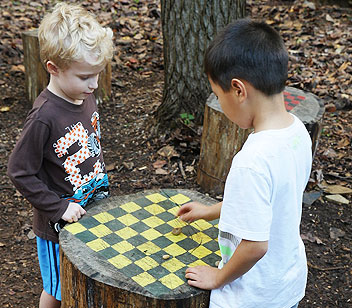Nature Play Spaces F.A.Q.
Main_Content
Natural play spaces offer all of the opportunities for creativity that a conventional playground can, while, at the same time, providing an important early connection for children with nature and promoting future environmental stewardship. Natural playgrounds often stimulate a child's imagination and creativity more than a traditional playground. Natural play spaces also support children’s physical, intellectual, and emotional development.
There has been an increased interest in connecting with nature since more and more studies have demonstrated the positive effects that outdoor recreation can have on children’s physical and mental health. At a time when childhood obesity and inactivity have become critical national issues of concern and environmental experts have begun to call the sustainability of our way of life into question, it has never been more imperative to get our kids outside.
The U.S. Consumer Product Safety Commission’s Public Playground Safety Handbook does not directly address nature play spaces; however there are many standards that can be applied to similar structures such as climbing stumps, surfacing etc. Some local jurisdictions, insurance carriers, agencies, or others may require it’s adherence to these standards. Certified Playground Safety Inspectors (CPSI), which are on staff at many state, county, and local parks departments, educational, and environmental agencies, apply the CPSC Guidelines and the relevant American Society for Testing and Materials (ASTM) Standards for Public Playground Safety and Surfacing to actual situations in play spaces. They can advise on preventive maintenance, and on applying the Guidelines in situations where manufactured play equipment is not involved.
Any new play areas and many alterations to existing play areas, including those less than 1,000 square feet are subject to regulation by the Americans with Disabilities Act. The 2010 Americans with Disabilities Accessibility Guidelines that became effective on March 15, 2011 place rules on access to parking, routes to the play area, number of play areas that must be accessible and play area amenities such as picnic tables and restrooms.

A good place to start would be our ‘Additional Resources’ section where you can find all kinds of information about nature play spaces, including the recommended safety guidelines, what other examples of nature play spaces around Maryland and the county look like, and how to get into contact with local experts and suppliers who can help you on your way!
Yes, when using real wood or trees or other natural materials, they may decay faster than pressure treated, or plastic structures. However, the benefit of natural materials is that if replacement is needed, they are usually easy to come by and very cheap. Plus, the experience of seeing a log decay adds a natural learning experience and new dimension to the play area.
To keep the elements safe and looking nice, you should regularly check on them with your routine playground safety inspections. You may need to sand wooden elements or make sure there is adequate drainage to keep elements from collecting moisture and rotting. Keep a log of inspections and recommended or completed improvements and repairs.  For more guidance see our safety information sheet.
For more guidance see our safety information sheet.
While a hollowed out log or other hiding space may seem like a great place for animals to make a home, the regular activity of visitors will keep animals from setting up shop in these areas. Animals are protective of their homes, and won’t build a den where a five year old is marching through and rearranging things!
Often nature play spaces are built for less money than a large structured playground. The up-front cost may mostly design fees and some materials for anything structured included in the design. However, since most materials are natural, they can usually be found from a local park (with permission), donated from a local landscaping or tree company, or even found on site. While you still must treat your surface area for fall zones, these fall zones are often not as high, and the amount of mulch or surfacing needed does not vary from a regular playground.
Also, many projects around the State have been installed with volunteers. From eagle scouts, to local artists, business and even rock climbing clubs, you may find engaging the community in the design and development will pay off in labor for installation and maintenance.
Many nature play spaces have other elements in them that are man-made. They sometimes include stages for encouraging performances, drama and active imaginary play. Some may include artwork from local artists or children and can vary in scale from oversized to miniature. A fun element in nature play spaces can include man-made elements that give a nod to local natural or cultural history of an area- maybe a canoe or small boat for a coastal town, or a toy train for a play space located near a train station.
